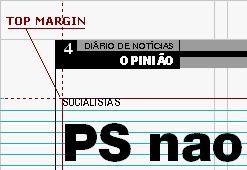About datelines and numbering
Datelines are local texts residing on a master page. Such local texts contan a series of markers (variables) that insert: edition date, edition number name, page number, section and zone name, and all of the edition and page attributes. This means that a dateline can automatically display the correct information for the page it is used on.
For the list of variables, see GNML variables - master pages.
You place datelines elements typically in separate frames: a frame for page number, a frame for edition date and number, a frame for section/zone banner.
The dateline area may be positioned on page in two ways:
| 1. | Outside of the page workspace, i.e. within the top page margin (as on figure below). |
| 2. | Within the page workspace. |
For the first case, you will have to increase the top margin value to accommodate the dateline area as well.
|
The reasons to displace the dateline area outside of the page workspace, is to simplify the displacement of the top most elements on the page - they will snap easily on their place below the top margin. Please be aware that snapping in Fred4 disallows positioning of items outside of margins. |
When the dateline area is inside the page workspace, it would be more error prone for overlapping of page elements with dateline area items.

